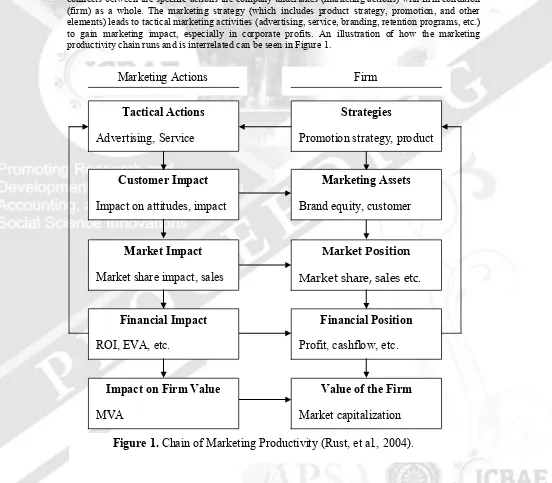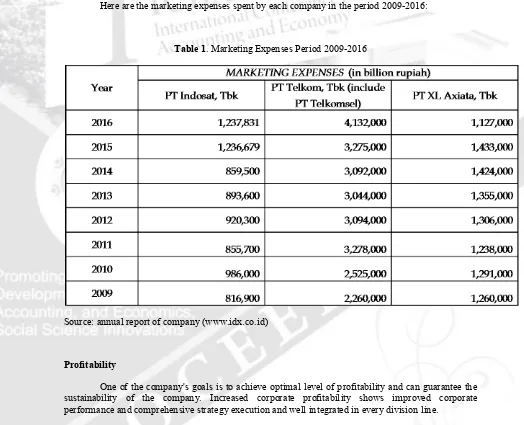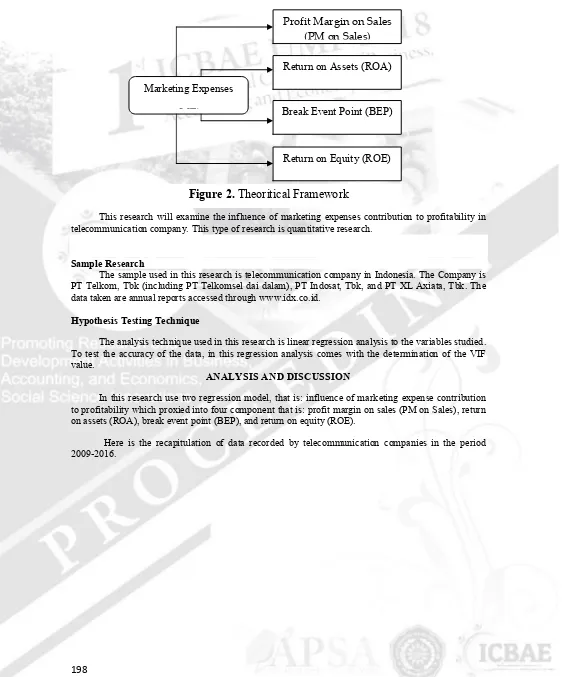MARKETING STRATEGY: MARKETING EXPENSE CONTRIBUTION TO
PROFITABILITY
(STUDY ON TELECOMMUNICATION COMPANY)
Totok Haryanto
feb.ump.th@gmail.com
Business and Economic Faculty of Universitas Muhammadiyah Purwokerto
ABSTRACT- In several previous research mentioned that there is influence between marketing expenses to profitability and firm value. However, some stakeholders and practitioners perceive that the budget for marketing expenses has already overspent, which means it is assumed that marketing expenses are very high cost and difficult to measure. In this research, will be analyzed about the contribution of marketing expenses to profitability of telecommunication company in Indonesia. Profitability is proxyed as profit margin on sales (PM on Sales), return on assets (ROA), break event point (BEP), and return on equity (ROE). This study also aims to give an idea that marketing activities in which there are marketing expenses, make a positive contribution to corporate profits.
Keywords: marketing expenses, PM on Sales, ROA, BEP, ROE, profitability. INTRODUCTION
There is a perception that marketing is considered as an overspent aspect in a company, as it is difficult to measure its effectiveness and efficiency. So we need an analysis that is used to measure marketing performance in accordance with the key performance indicator (KPI) is set. The analysis should be objective and measurable so that it can be used to assess the level of profitability and productivity of the company.
Profitability analysis in the marketing context is an assessment done to examine the effects of various marketing strategies and tactics on the expected profit contribution by the firm. While productivity analysis is an assessment of the consequences of sales or market share that can result from the implementation or realization of marketing strategies and tactics that have been set. The productivity analysis is concerned with estimating the correlation between the price or marketing cost incurred (eg advertising costs) with the volume and value of sales or market share that can be achieved within a certain period.
Statistical data taken from www.statista.com, said that in 2010 until 2013, marketing expense (marketing expenses) in Indonesia is always increasing every year. In 2010 marketing expenses in Indonesia reached 5.5 billion US Dollars and in 2013 reached 9.14 billion US Dollars and is projected to increase every year. As with the results of Moormand & Rust (1999), marketing activities have a significant effect on sales. Supported also by another study, Kim & Jaewoo (2013) concluded that expensed marketing expenses can lift sales in all industries studied. Furthermore, research conducted by Luo & de Jong (2012), using stock return and risk as a dependent variable, found that marketing expenses can also affect firm value of the firm.
In this research, will be analyzed about the contribution of marketing expenses to profitability of telecommunication company in Indonesia. Profitability is proxied as profit margin on sales (PM on Sales), return on assets (ROA), break event point (BEP), and return on equity (ROE). This study also aims to give an idea that marketing activities in which there are marketing expenses, giving a positive contribution to corporate profits.
The marketing strategy was implemented by the company is closely related to how much it will cost them. This will be an important assessment for each manager to determine how much the cost will be set, so that will contribute positively to the company.
According to Fandy Tjiptono (2008), said that there are two approaches in the process of determining and preparing marketing costs, namely:
1. Direct Approach
In this approach, the company, in this case the marketing manager, will develop a specific estimate of how much sales will result from a certain price or marketing cost. The steps in this direct approach are:
a. Establish industrial sales projection.
b. Estimating market share resulting from marketing costs to be incurred. c. Calculate expected company sales (market share x projected industry sales). d. Calculate the contribution of variables (company sales x PVCM)
e. Calculates the total contribution (variable contribution margin - direct costs and fixed costs that can be traced).
f. Determine whether sales, market share, and total contribution levels can be accepted based on product goals.
2. Indirect Approach
In this approach, projected sales productivity at a certain price and cost is not required. The manager estimates whether a given level of sales (benchmark level of sales) can be achieved. The steps in this approach are as follows:
a. Set the level of total contribution to be achieved.
b. Calculates the required level of sales to achieve a targeted contribution to a certain price level and marketing cost.
c. Calculate the required market share
d. Based on the projected productivity and marketing costs, it will determine whether the required sales and market share can be achieved.
e. Determine whether the required market and sales share are acceptable based on product targets.
Previous Research
1. Muhammad Teguh Akbar Kombih Novrys Suhardianto. The Influence of Marketing Activities, Financial Performance, And Intangible Assets To Company Value. Year 2017.
a. Variable: (1) marketing activity (expenses), (2) Return on Asstes / ROA, (3) Current Ratio / CR, (4) Debt to Equity Ratio / DER, (5) Tobin's Q.
b. Result of research: mentioned that marketing activity, profitability, and solvency will increase company value.
2. Sonya Serenia and Saarce Elsye Hatane. The Influence of Marketing Activities on Profitability and Value of Property and Real Estate Companies in BEI. Year 2015
a. Variable: (1) marketing cost, (2) company size, (3) company age, (4) Return on Asstes / ROA, (5) Earning Per Share / EPS, (6) Tobin's Q, (7) market to book ratio.
b. Research result:
1) The age of a company that is a component of marketing activities has a positive influence on profitability and corporate value.
2) Marketing costs have a positive and significant influence on profitability and firm value represented by EPS and Market to Book Ratio.
3) The size of the company has a negative relationship to profitability and positive to the value of the company represented by EPS and Tobins'Q
a. Variables under study: (1) strategy and tactics, (2) brand equity, (3) customer equity, (4) market impact, (5) financial impact, (6) environment, and (7) competition. The emphasis is on aggregate-level models that link tactics with financial impact.
b. Result of research: that marketing expense (marketing expenses) simultaneously can give added value to value that will be obtained by shareholder.
Marketing Expenses
According to Cambridge Dictionaries Online, marketing costs are the amount of money allocated by the company for marketing activities. Marketing expenses are an important consideration for all businesses because marketing is a key business function that creates customers for business. It is important for business owners to understand the importance of marketing costs, their management, and their tax treatment. Typically, some general marketing expenses include marketing salaries, marketing research, promotions, public relations, and advertising costs (smalbusiness.chron.com, 2018).
In an effort to assess marketing costs used for promotional purposes, new product development, and so on, each company needs to design a business model capable of tracking the impact of marketing costs on consumer understanding, beliefs, feelings, attitudes and behavior. One model that can be used is the chain of marketing productivity model (Rust, et al., 2004). In the model it connects between the specific actions the company undertakes (marketing actions) with firm condition (firm) as a whole. The marketing strategy (which includes product strategy, promotion, and other elements) leads to tactical marketing activities (advertising, service, branding, retention programs, etc.) to gain marketing impact, especially in corporate profits. An illustration of how the marketing productivity chain runs and is interrelated can be seen in Figure 1.
Tactical Actions
Marketing Expenses Analysis
On an ongoing basis, firms must assess appropriate marketing cost levels based on their return on investment and industry standards. Marketing spending should be evaluated and measured across its components, including the general cost to sales ratio to determine its effectiveness. For example, a business owner can calculate a ratio such as the ratio of advertising to sales, the ratio of promotion to sales, and the ratio of selling costs to sales. Keeping these ratios and variations in mind over time and comparing them with industry benchmarks, then business owners can confirm that they are spending their marketing expenses effectively and efficiently.
Here are the marketing expenses spent by each company in the period 2009-2016:
Table 1. Marketing Expenses Period 2009-2016
Source: annual report of company (www.idx.co.id)
Profitability
One of the company's goals is to achieve optimal level of profitability and can guarantee the sustainability of the company. Increased corporate profitability shows improved corporate performance and comprehensive strategy execution and well integrated in every division line.
Profitability is another important measure for assessing performance, where a company can not possibly continue to grow without the benefits available for the company to invest (Fitzsimmons, Steffens, & Douglas, 2005).
Here is the profitability ratios that reflect the final outcome of all financial policies and operational decisions by Brigham, Houston (2010: 146):
1. Profit Margin on Sales (PM on Sales)
The PM on Sales ratio is the calculation of the company's net profit divided by the amount of sales.
Hypothesis 1. Marketing expenses effect on Profit Margin on Sales
2. Return on Assets (ROA)
ROA ratio is used to measure return on total assets used in company operations.
Here's the formula:
Hypothesis 2. Marketing expenses effect on Return on Assets (ROA) 3. Break Event Point (BEP)
The BEP ratio is used to measure the firm's basic ability to generate profits by dividing the amount of earnings before interest and tax (EBIT) by total assets.
Here's the formula:
Hypothesis 3. Marketing expenses effect on Break Event Point (BEP)
4. Return on Equity (ROE)
ROE is the ratio of net income to ordinary equity used to measure the return on ordinary shareholder investment. Shareholders can know how much dividend return can be seen by using this ratio.
Here's the formula:
Hypothesis 4. Marketing expenses effect on Return on Equity (ROE)
The four components in the measurement of profitability above is the rationale in this study to analyze the extent of marketing costs (marketing expenses) can give impact (impact) on the level of profitability of the company.
Profit Margin on Sales
=
Nett Profit
Sales
Return on Assets
=
Nett Profit
Total Asset
Break Event Point
=
EBIT
Total Asset
Return on Equity
=
Nett Profit
Theoritical Framework
Based on the hypothesis developed in this study, here is an illustration of the theoretical framework:
RESEARCH METHODS
This research will examine the influence of marketing expenses contribution to profitability in telecommunication company. This type of research is quantitative research.
Sample Research
The sample used in this research is telecommunication company in Indonesia. The Company is PT Telkom, Tbk (including PT Telkomsel dai dalam), PT Indosat, Tbk, and PT XL Axiata, Tbk. The data taken are annual reports accessed through www.idx.co.id.
Hypothesis Testing Technique
The analysis technique used in this research is linear regression analysis to the variables studied. To test the accuracy of the data, in this regression analysis comes with the determination of the VIF value.
ANALYSIS AND DISCUSSION
In this research use two regression model, that is: influence of marketing expense contribution to profitability which proxied into four component that is: profit margin on sales (PM on Sales), return on assets (ROA), break event point (BEP), and return on equity (ROE).
Here is the recapitulation of data recorded by telecommunication companies in the period 2009-2016.
Marketing Expenses
(ME)
Profit Margin on Sales (PM on Sales)
Return on Assets (ROA)
Break Event Point (BEP)
Return on Equity (ROE)
Table 2. Recapitulation of PM on Sales, ROA, BEP, and ROE
Source: annual financial statement (www.idx.co.id)
From the above data recapitulation, to know the influence of marketing expenses to the level of profitability of the company, it will be tested regression model of each component variable.
Here are the results of the regression test:
Table 3. Result of The Regression Test
Source: result of data processing (output SPSS)
From the table above shows that each variable tested has a significant positive effect because the significance level is less than 0.05 (Column Sig. = 0.000). While the VIF value is less than 10 (VIF = 1,000), which means that the data tested does not occur multicollinearity.
CONCLUSIONS AND SUGGESTIONS Conclusion
From the results of analysis and discussion of research, it can be concluded as follows:
1. There is a significant positive influence of marketing expenses (ME) on profit margin on sales (pm on sales), with a level of influence of 79.8% (R2 value). This means that with the marketing expenses spent, the profit margin on sales of the company will increase by 79.8%. 2. There is significant positive influence of marketing expenses (ME) on return on assets (ROA),
3. There is a significant positive effect of marketing expenses (ME) on the break event point (BEP), with an influence level of 51.9% (R2 value). This means that with the marketing expenses spent, the company's BEP will increase by 51.9%.
4. There is a significant positive effect of marketing expenses (ME) on return on equity (ROE), with an influence rate of 24.5% (R2 value). This means that with the marketing expenses spent, the company's ROE will increase by 24.5%.
Suggestion
For future research, the other financial aspects will be added as additional variables, so that more details about other factors can affect the level of profitability, especially in marketing activities.
REFERENCES
Amato, Louis H., Burson, Thimothy E. 2007. The Affect of Firm Size on Profit Rates in Financial Services. Journal of Economics and Economic Education Research. The Dream Catcher Group. ISSN: 1533-3604.
Ambler, Tim. 2000. Marketing and the Bottom Line. London: Financial Times/Prentice Hall.
Bowd, Ryan and Les Bowd. 2002. Assessing the Financial Value of Corporate Reputation: Suggestions for a Proposed Formula, Working Paper WP02/01. Manchester Metropolitan University
Business School.
Brigham, Houston. 2010. Dasar-dasar Manajemen Keuangan. Jakarta: Penerbit Salemba Empat Edisi 11.
Davis, Craig R. 2002. Calculated Risk: A Framework for Evaluating Product Development. Sloan Management Review, 43 (4), 71–77
Fitzsimmons, J. R., Steffens, P., & Douglas, E. 2005. Growth and Profitability in Small and Medium Sized Australian Firms. AGSE Entrepreneurship Exchange.
Grewal,D., G.R.Iyer, W.A.Kamakura, A.Mehrotra, and A.Sharma. 2009. Evaluation of Subsidiary Marketing Performance: Combining Process and Outcome Performance Metrics. Journal of the Academy of Marketing Science 37 (2):117-129
Harmono. 2009. Manajemen Keuangan. Jakarta: PT Bumi Aksara.
Harris, Lloyd C. 2001. Market Orientation and Performance: Objective and Subjective Empirical Evidence from UK Companies, Journal of Management Studies, 38 (1), 17–43.
Kanagal,N.2009. Role of Relationship Marketing In Competitive Marketing Strategy. Journal of Management and Marketing Research 2(Mei): 1-17.
Kim, Y., and Jaewoo, J. 2013. The Moderating Effect of Product Market Competition In the Relationship Between Advertising Expenditures and Sales. Journal of Applied Business Research.
Luo, X., and de Jong, P. 2012. Does Advertising Spending Really Work? The Intermedate Role of Analysts in the Impact of Advertising on Firm Value. Journal of Academy Marketing.
Moorman, C., and Rust, R. 1999. The Role of Marketing. Journal of Marketing.
Muhammad Teguh Akbar Kombih Novrys Suhardianto. 2017. Pengaruh Aktivitas Pemasaran, Kinerja Keuangan, dan Aset Tidak Berwujud Terhadap Nilai Perusahaan. Jurnal Ekonomi dan Keuangan. v1.i3.1909
Rust R.T., T. Ambler, G.S. Carpenter, V. Kumar, and R.K. Srivastava. 2004. Measuring Marketing Productivity: Current Knowledge and Future Directions. Journal of Marketing. Vol. 68.
Smallbusiness.chron.com. 2018. What is Marketing Expenses. http://smallbusiness.chron.com/marketing-expense-25648.html. (Accessed April 28, 2018)
Sonya Serenia dan Saarce Elsye Hatane. 2015. Pengaruh Kegiatan Marketing terhadap Profitabilitas dan Nilai Perusahaan Properti dan Real Estate di BEI. Business Accounting Review, Vol. 3, No. 1, Januari 2015
Statista. 2018. Advertising spending in Indonesia from 2010 to 2018 (in billion U.S. dollars). http://www.statista.com. (Accessed April 28, 2018)
Tjiptono F., Chandra G., Adriana D. 2008. Pemasaran Strategik. Yogyakarta: Penerbit Andi.
V. Wiratna S.. 2016. Penelitian Akuntansi dengan SPSS. Yogyakarta: Penerbit Pustaka Baru Press.



